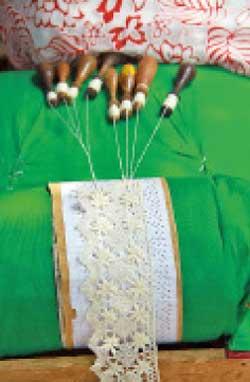 Shining a spotlight on the need to preserve the cultural heritage of local artisans while empowering them through design Sri Lanka Design Forum 2021 will witness a unique discourse by Victoria Walker. AODs Design For Sustainable Development Foundation Honorary Chair Victoria Walker, a passionate flagbearer for the craft movement elucidates a unique narration of Sri Lankan Crafts & the new world.
Shining a spotlight on the need to preserve the cultural heritage of local artisans while empowering them through design Sri Lanka Design Forum 2021 will witness a unique discourse by Victoria Walker. AODs Design For Sustainable Development Foundation Honorary Chair Victoria Walker, a passionate flagbearer for the craft movement elucidates a unique narration of Sri Lankan Crafts & the new world.

Q
The Founder of AOD Linda Speldewinde recently spoke about Sri Lanka’s new ‘economic trinity’ combining agriculture, craft and sustainable tourism, with the village as its centre. How does this bode for the Design for Sustainable Development Foundation of Sri Lanka?
Sri Lanka’s Design for Sustainable Development Foundation (DFSD) was established by AOD in 2011 to support and promote Sri Lanka’s rural artisans. Its founding vision remains one of using design and design thinking to promote sustainable development in the craft sector. To realise this vision, it is important we encourage sustainability in all we do, including responsible sourcing of raw material, minimising waste and encouraging sustainable tourism practices.
Q In the Sri Lankan education system, emphasis is on traditional subjects with little or no emphasis on crafts. How will this “lack” help to achieve success in attracting people to work in the craft sector?
You have touched on a critical point for Sri Lankan craft: unless young people see a future in the sector, they will not take on the mantle from the current generation of artisans. Indeed, there are already craft skills in Sri Lanka that have been lost, or are endangered.
The answer to this has many facets, including education.
In my view, the nub of the issue is that the community at large needs to value, appreciate and support Sri Lankan craft in order for the next generation of artisans to want to join the sector. I am not talking about charity: skilled craftspeople do not want or need charity. But they do need customers – people who love and value their products and are willing to pay a fair price for beautiful handmade items. This is about understanding, knowledge and, yes, education.

Q
People are moving away from working in craft industries such as weaving and batik. What can industry stakeholders do to make these occupations more attractive?
I think it is instructive to look at examples where craft is thriving in Sri Lanka address this question. While there is no one answer on how to promote craft, some of the themes identified by the most successful and dynamic organisations working in craft today in featured in the CRAFTing impACT sessions in SLDF included the following:
Articulating and promoting a clear people-centred vision
Involving artisans as partners and collaborators
Paying fair wages, ensuring family-friendly practices particularly for women artisans
Adapting and innovating in response to new circumstances
Emphasising quality design
Collaborating with and learning from others
Q There is a lot of discourse about empowering artisans. How can this be done as many of the artisans especially in rural areas are exploited?
One of the most effective ways to encourage ethical and responsible practices in the craft sector is to highlight and promote those who are doing outstanding work. Word gets out quickly in artisan communities about which organisations are fair, respectful and trustworthy. Block chain technology will help drive this further in future.
At the same time, many consumers want to know that their craft purchases were made safely and sustainably, and that artisans were properly recognised and compensated. Again, this favours responsible organisations – such as those we feature in SLDF - over those who seek to exploit artisans.
One of the most effective ways to encourage ethical and responsible practices in the craft sector is to highlight and promote those who are doing outstanding work.

Q
Attempts by the state to revamp the craft industry and take our products abroad have not seen much success. How can the private sector step in and change the fortunes of our craft exports?
Both the public and private sector have important roles in promoting Sri Lanka’s craft export industry: the two sectors have different but complimentary resources and perspectives to bring to the task. Critical in this marketing effort is a clear articulation of the many ways in which Sri Lankan craft is distinctive and special. This is something that we cover in the SLDF sessions on craft.
Q How do events like Sri Lanka Design Festival benefit rural artisans and craftspeople?
By showcasing craft from a range of vantage points - including fashion, design education and from the perspective of industry leaders – SLDF aims to demonstrate the vibrancy of the sector and to inspire and energise our domestic and international audiences. This, in turn, is critical for developing the sort of understanding and support needed for the craft sector to thrive into the future.
 Shining a spotlight on the need to preserve the cultural heritage of local artisans while empowering them through design Sri Lanka Design Forum 2021 will witness a unique discourse by Victoria Walker. AODs Design For Sustainable Development Foundation Honorary Chair Victoria Walker, a passionate flagbearer for the craft movement elucidates a unique narration of Sri Lankan Crafts & the new world.
Shining a spotlight on the need to preserve the cultural heritage of local artisans while empowering them through design Sri Lanka Design Forum 2021 will witness a unique discourse by Victoria Walker. AODs Design For Sustainable Development Foundation Honorary Chair Victoria Walker, a passionate flagbearer for the craft movement elucidates a unique narration of Sri Lankan Crafts & the new world. Q The Founder of AOD Linda Speldewinde recently spoke about Sri Lanka’s new ‘economic trinity’ combining agriculture, craft and sustainable tourism, with the village as its centre. How does this bode for the Design for Sustainable Development Foundation of Sri Lanka?
Q The Founder of AOD Linda Speldewinde recently spoke about Sri Lanka’s new ‘economic trinity’ combining agriculture, craft and sustainable tourism, with the village as its centre. How does this bode for the Design for Sustainable Development Foundation of Sri Lanka? Q People are moving away from working in craft industries such as weaving and batik. What can industry stakeholders do to make these occupations more attractive?
Q People are moving away from working in craft industries such as weaving and batik. What can industry stakeholders do to make these occupations more attractive? Q Attempts by the state to revamp the craft industry and take our products abroad have not seen much success. How can the private sector step in and change the fortunes of our craft exports?
Q Attempts by the state to revamp the craft industry and take our products abroad have not seen much success. How can the private sector step in and change the fortunes of our craft exports?